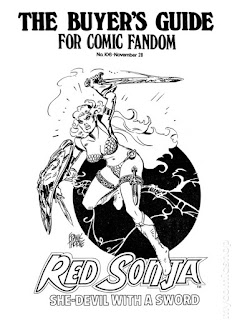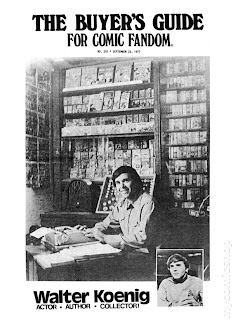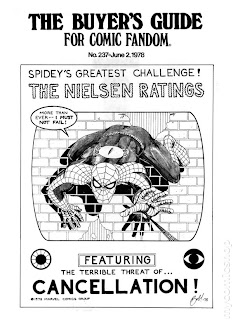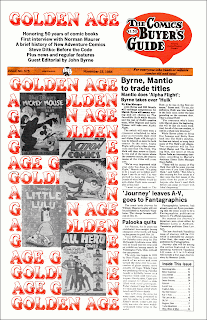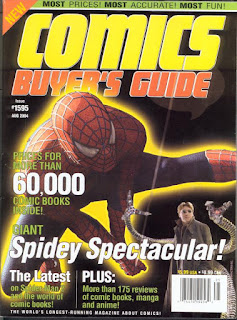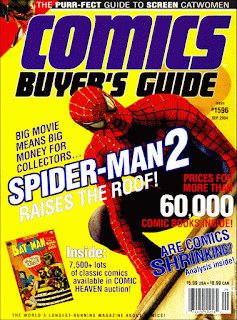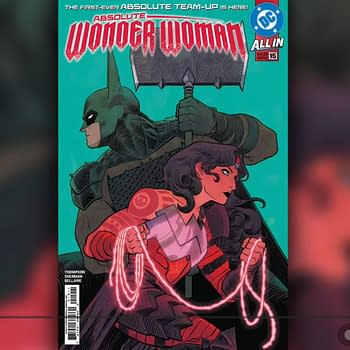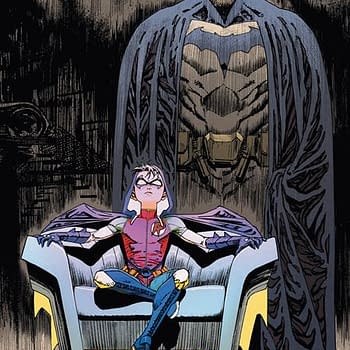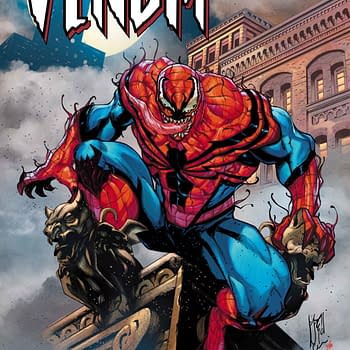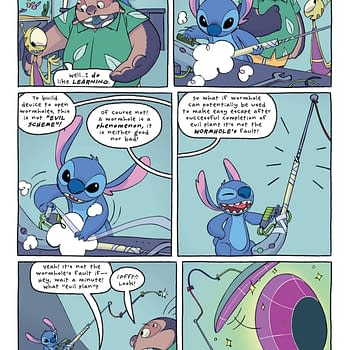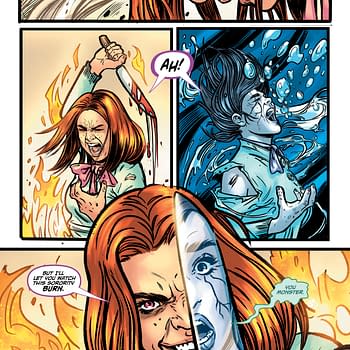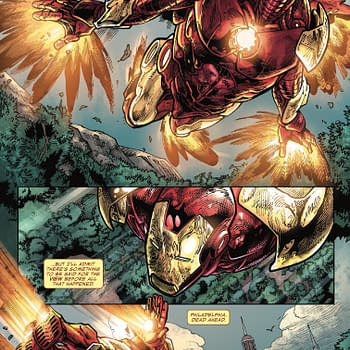Posted in: Comics | Tagged:
The End Of Comics Buyers' Guide With #1699
John Jackson Miller looks at the life of the Comics Buyer's Guide, announced as being cancelled by Krause Publications with issue 1699, above.
Today, F+W Media announced the closure of Comics Buyer's Guide after the publication of its 1,699th issue (March 2013). The magazine, which began life in the basement of a comics fan in 1971 was for many years the largest marketplace for comics sales by mail — as well as being the leading news source for many fans during the weekly portion of its run.
Quite a lot about the history of comics, both as a hobby and as an entertainment medium,
can be seen in the pages from its 42-year history. It was a history that was filled with highs and lows and quite a few changes. Some changes were caused from external events; others, from moves by its owners.
It isn't my intent to tell those stories now — there are a number of posts that could be written telling some of those stories, and I expect to at some point down the road. But now, just at the announcement of its cancellation, I hope to provide some broad perspective on the magazine.
It certainly played a major role in my life, both as a collector and as a publishing professional. A regular reader of the publication since 1984, I went to work for CBG's spinoff retail publication Comics Retailer (later Comics & Games Retailer) in late 1993. I would be involved at one level or another with the publication ever after, as a contributing editor, as a managing editor, as editorial director for the division and later the company — and, finally, after I left in 2007 to write full time, as an outside columnist. The magazine has been there in one way or another in my life for nearly 30 years. But it existed long before that.
The Alan Light years
(1971-1983). As noted, Comics Buyer's Guide began life when Alan Light, then 17, launched his own trade newspaper, The Buyer's Guide for Comic Fandom, in February 1971. Fandom was in full swing, then, with Robert Overstreet's first Comic Book Price Guide just published. Fanzines were providing most of the mail order connections for comics collectors, and Light's addition was crafted as an ad-zine, charging $30 for its full-page ads. The circulation for the broadsheet newspaper was 3,600 copies, and subscriptions were available for free to requesting readers. (Ads in that first issue included two different copies of Amazing Spider-Man#1 — for $11 and $4 respectively!)
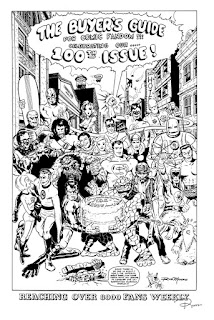 The "TBG" — as people referred to it, despite the article already being in the acronym — shifted from bimonthly to monthly with its second issue. Editorial content was scarce in the early issues (although later regular Mark Evanier did have a column in the fourth issue). With artists including Klaus Janson and P. Craig Russell providing some of the earliest covers, circulation topped 4,000 in early 1972. With issue #18 (Aug. 1, 1972)
The "TBG" — as people referred to it, despite the article already being in the acronym — shifted from bimonthly to monthly with its second issue. Editorial content was scarce in the early issues (although later regular Mark Evanier did have a column in the fourth issue). With artists including Klaus Janson and P. Craig Russell providing some of the earliest covers, circulation topped 4,000 in early 1972. With issue #18 (Aug. 1, 1972)
it went biweekly. That issue included the publication's first convention photo feature, on the 1972 New York ComiConvention. (I indexed the first hundred or so issues years ago for the CBG website; while it lasts, you can find it here. Russ Maheras provided all the scans.)
As TBG became a bigger and bigger production, Murray Bishoff joined Light as an assistant — and the magazine brought in the couple who would become synonymous with it in later years: Don and Maggie Thompson. Sometimes (and in my view, rightly) regarded as the "George and Martha Washington of comics fandom," Don and Maggie had produced one of the first comics fanzines in 1961 and had continued in their own publication Newfangles (seen here). The Thompsons had first appeared in TBG #14 to continue the fan awards they'd started in Newfangles — and Light brought them in
as columnists in #19 (Aug. 15, 1972). Their "Beautiful Balloons" column would
run in alternating issues for years after that.
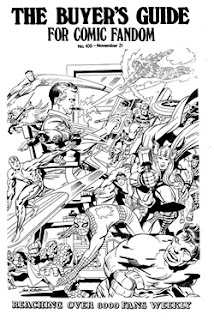 There's a reason why alternating issues were usually often the only place you could find editorial content in the early TBGs. It was only there at all because with the Dec. 1, 1972 issue (#26) TBG stopped being free and became a paid subscription publication — $2 for 23 issues. By changing from a requestor publication to a paid one, the Postal Service required that advertising could fill no more than 75% of the magazine's pages. Since the auditing period back then was two issues, Light chose to run all ads in one issue, and with the next being half editorial. So #26 included regular news sections, including "Now What," by Bishoff.
There's a reason why alternating issues were usually often the only place you could find editorial content in the early TBGs. It was only there at all because with the Dec. 1, 1972 issue (#26) TBG stopped being free and became a paid subscription publication — $2 for 23 issues. By changing from a requestor publication to a paid one, the Postal Service required that advertising could fill no more than 75% of the magazine's pages. Since the auditing period back then was two issues, Light chose to run all ads in one issue, and with the next being half editorial. So #26 included regular news sections, including "Now What," by Bishoff.
And there was a lot of content. Golden Age creators like Bill Everett were eulogized. Marvel's expansion in the early 1970s was covered. Articles on attempts to censor comics appeared as early as 1973, with a piece on Direct Market pioneer Phil Seuling's arrest for selling undergrounds. Coverage expanded when the publication went weekly with #87 (July 18, 1975), adding media topics. A movie called The Star Wars (sic) was announced as a Christmas 1976 release in TBG #97 (Sept. 26, 1975); San Diego Comic-Con cofounder Shel Dorf would later provide one of the only fandom interviews with Harrison Ford for TBG.
Big news stories appeared throughout the 1970s. Superman creator Jerry Siegel spoke out in fandom for the first time in a piece that ran in TBG #105 (Nov. 21, 1975), "The Victimization of Superman's Creators." (The issue, seen at left, had an original Jack Kirby cover.) The magazine aggressively covered the drive to get pensions for him and Joe Shuster, and was able to announce their settlement in #113, two months later.
The advertising base continued to grow — now including Steve Geppi, today of Diamond Comic Distributors, whose testimonial ad for TBG ran in #71 (Mar. 1, 1975). As a result, the newspaper continued to expand — some issues had as many as four folded over sections — with the Thompsons' column expanding to take up nine full pages of the newspaper by 1976. (The largest issue of TBG was #190, the July 8, 1977 issue, which ran 148 pages, including a 52-page catalog from Mile High Comics.) And pure entertainment features were added, with Fred Hembeck launching his Dateline cartoon.
The industry was changing quickly, with editorial upheaval at Marvel, runaway cover price inflation, and troubles in the newsstand market filling many columns. News of layoffs at Charlton reached readers in 1976. TBG #257 (Oct. 20, 1978) reported the publication of Cancelled Comics Cavalcade, a consequence of the DC Implosion. But with its circulation topping 10,000 copies in 1977, TBG was also reporting on the nascent comics shop market, its ads connecting start-up distributors to start-up retailers. Seuling's first ad introducing Sea Gate Distributors appeared on the back of TBG #207, the Nov. 4, 1977 issue.
And the newspaper had long provided a venue for smaller publishers to reach readers. Underground publishers Rip Off Press and Last Gasp began advertising in 1973, and many more alternative publishers followed. Jack Katz's First Kingdom was featured in 1977, one of many indie spotlights to follow. (People advertised to sell and find all sorts of things — including subscriber Walter Koenig of Star Trek, who was looking to expand his button collection.)
The 1970s TBG also covered collectors' issues, including the price spikes on early "hot comics" like Conan #1, Howard the Duck #1, and Red Sonja #1. It also warned of the publication of the first counterfeit comic book, a version of Eerie #1, in 1976. (CBG would also later warn of the Cerebus #1 counterfeit among many others.)
As the 1980s began, TBG had really grown into its role as more than an ad sheet. Cat Yronwode had taken over Bishoff's news column with TBG #329 (March 7, 1980), renaming it "Fit to Print," and a lot of players inwhat would be the modern Direct Market were in place. But after publishing 481 issues comprising 33,000 pages, Alan Light, then just 29, decided he'd had enough. He sold the publication to Krause Publications of Iola, Wis.
The Don and Maggie years (1983-1994). Krause was owned by Chester "Chet" Krause, who, like Light, had started his own magazine from his kitchen table — Numismatic News for coin collectors — in 1952. The company had acquired or started several publications in other collectibles fields, and determined to follow that model in comics. That meant turning TBG into Comics Buyer's Guide — putting the comics word up front — and it meant hiring Don and Maggie Thompson as its coeditors.
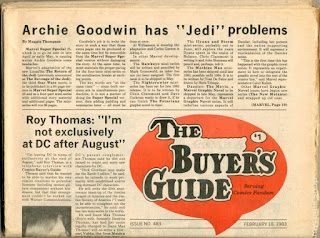 The first Krause issue, #482 (Feb. 11, 1983) was a shock for some. The folded-over newsprint publication had much higher production values — and as with all Krause publications, handwritten ads were typeset by the production staff. (This earned the derision of one reader, who said he could no longer tell which sellers were idiots by the quality of their ads.) The every-other-week editorial thing went away, with each issue now 25% editorial. A paid classified ad section was added, often running many pages. Yronwode, Hembeck, and other features were brought into the new CBG. The word "comics" was added very gradually to the logo, growing in weight and size every week.
The first Krause issue, #482 (Feb. 11, 1983) was a shock for some. The folded-over newsprint publication had much higher production values — and as with all Krause publications, handwritten ads were typeset by the production staff. (This earned the derision of one reader, who said he could no longer tell which sellers were idiots by the quality of their ads.) The every-other-week editorial thing went away, with each issue now 25% editorial. A paid classified ad section was added, often running many pages. Yronwode, Hembeck, and other features were brought into the new CBG. The word "comics" was added very gradually to the logo, growing in weight and size every week.
Included in that first issue was a new one: "Comics in Your Future," a highly detailed week-by-week listing of what was shipping. It would run for more than 20 years, before switching to the magazine's website. And the Thompsons added "Oh, So?" a letters-column feature that was populated by fans and creators alike. Erik Larsen was one of the writers in that first column; and over the course of the next decade-plus, John Byrne sent dozens of letters that were published.
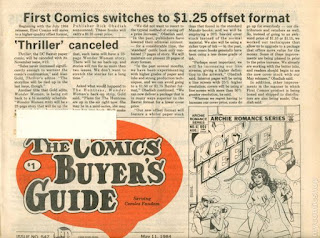 Don began the Comics Guide review column, and the Thompsons
Don began the Comics Guide review column, and the Thompsons
immediately revived their fan awards, which had started back in Newfangles. The first CBG Fan Awards
issue ran in CBG #500, the Jun. 17, 1983 issue. (Frank Miller was the big
winner.) Fan Awards ballots would appear in comics from Marvel and many other publishers, with award ceremonies at Chicago Comicon for many years. The program — which, yeah, was also a way of getting prospective subscribers' addresses
— was getting something like 5,000 votes mailed in at its 1990s peak.
CBG was, in fact, part of a two-pronged entry into the comics field for Krause in 1983. Alex G. Malloy, Neil A. Hansen, and Richard Maurizio packaged a first issue of a newsstand magazine, Comics Collector, for Krause. Krause gave the title to the Thompsons to edit thereafter, and while the magazine only lasted 10 issues, the price guide included in it would later form the basis for Comics Buyer's Guide Price Guide magazine in the 1990s, the CBG Checklist and Price Guide book series, and the Standard Catalog of ComicBooksseries.
CBG, meanwhile, prospered thanks to subscription efforts and direct market distribution, with circulation topping 20,000 copies by the early 1990s. With the Thompsons at the helm, CBG continued to report on industry news. Expansion in the Direct Market brought more rounds of
speculation, such as the run on 1984's Amazing Spider-Man #252 (with the black costume) and 1986's Dark Knight Returns #1. The many failed attempts at Spider-Man, Batman, and Watchmen films provided lettercol fodder. Censorship remained a major topic, following the Friendly Frank's case and creators' attempt to stave off a ratings system. The debate over Marvel and Jack Kirby's artwork filled many pages. And the top-selling issue of the 1980s was 1987's issue reporting Jim Shooter's departure from Marvel.
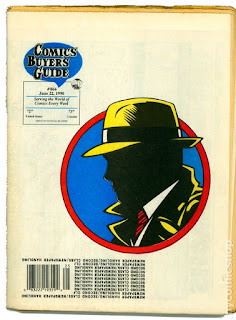 The ease with which the Direct Market made self-publishing possible made the publication an important vehicle for a plethora of new publishers. Teenage Mutant Ninja Turtles #1 was first advertised by its publishers in CBG #542 (Apr. 6, 1984) for $2 postpaid, and CBG followed with reports throughout the black-and-white comics glut that followed in the mid-1980s. The Thompsons promoted many up-and-coming creators, with Don later evangelizing for Jeff Smith's creation Bone in the early 1990s.
The ease with which the Direct Market made self-publishing possible made the publication an important vehicle for a plethora of new publishers. Teenage Mutant Ninja Turtles #1 was first advertised by its publishers in CBG #542 (Apr. 6, 1984) for $2 postpaid, and CBG followed with reports throughout the black-and-white comics glut that followed in the mid-1980s. The Thompsons promoted many up-and-coming creators, with Don later evangelizing for Jeff Smith's creation Bone in the early 1990s.
Theme issues for international and media-related comics appeared in the first Krause decade, as did many new columnists. Tony Isabella, who had written for the original TBG, started a regular presence in the 1980s, as did Heidi MacDonald, now of ComicsBeat.com. Bob Ingersoll wrote a legal column. And Peter David, who first appeared as a Marvel representative in CBG's pages, started his "But I Digress" column in CBG #871 (July 27, 1990); he would serve as the inside-back-page columnist ever after.
 By the early 1990s, the comics industry was amid the biggest boom of its history, driven by speculation and the availability of easy credit from comics distributors. CBG reported that annual sales in 1991 were $475 million — including the newsstand; that figure would reach $850 million in 1993. (By contrast, the Direct Market alone in 2012 had sales of $475 million, with the wider marketplace bringing it north of $700 million — in today's dollars, that is.) CBG reported on one boomlet after another, from the bagged Spider-Man #1 and 1992's "Death of Superman." The magazine switched to a tabloid in 1992 for easier shipping, which opened up the cover again for art. After reporting on distributors and their conferences for many years, CBG spun off all business material into Comics Retailer in 1991.
By the early 1990s, the comics industry was amid the biggest boom of its history, driven by speculation and the availability of easy credit from comics distributors. CBG reported that annual sales in 1991 were $475 million — including the newsstand; that figure would reach $850 million in 1993. (By contrast, the Direct Market alone in 2012 had sales of $475 million, with the wider marketplace bringing it north of $700 million — in today's dollars, that is.) CBG reported on one boomlet after another, from the bagged Spider-Man #1 and 1992's "Death of Superman." The magazine switched to a tabloid in 1992 for easier shipping, which opened up the cover again for art. After reporting on distributors and their conferences for many years, CBG spun off all business material into Comics Retailer in 1991.
As the comics glut reached epic proportions with more than 500 comics coming out a month, the Thompsons famously editorialized for restraint. CBG issues ran over 120 pages many weeks — still running at a 75/25 ad-to-edit ratio — stuffed with ads from comics dealers. With Wizard starting to attract readers, Krause tried to improve the salability of the magazine by publishing the issue as an upright single-section tabloid, with a color cover. But many comics shops refused to carry CBG because of the perceived competition from its ads — a problem that would harm it greatly later on.
Wisconsinite Brent Frankenhoff joined the staff as Don's associate editor in September 1992, and publisher Greg Loescher hired me to take over Comics Retailer in November 1993. (On Don's behalf, Brent had previously mailed the rejection letter for my sole submission to CBG, a comic strip; I would rib him over that fact for many years. They were right to reject it, of course — no cartoonist I!) By the end of 1993, the comics industry was on the brink of a historic collapse.
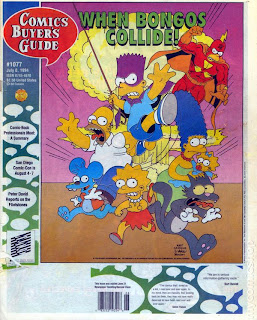 And sadly, Don's health was failing, too. He continued to write his review column from a hospital bed in late 1993, and kept up a busy schedule into 1994. Very busy — I have to say I have never seen anyone work as hard as Don Thompson did. He was in the office at all hours, working on those gargantuan papers. He died in May 1994 at 58, having reviewed more than 10,000 comics in his career; his and Maggie's work together had appeared in 739 issues of the combined magazines.
And sadly, Don's health was failing, too. He continued to write his review column from a hospital bed in late 1993, and kept up a busy schedule into 1994. Very busy — I have to say I have never seen anyone work as hard as Don Thompson did. He was in the office at all hours, working on those gargantuan papers. He died in May 1994 at 58, having reviewed more than 10,000 comics in his career; his and Maggie's work together had appeared in 739 issues of the combined magazines.
CBG #1074 (June 17, 1994) was hours from going to press when Don died; somehow, Maggie managed to get an obituary and remembrance note in that issue. The first condolence note across the fax machine came from Neil Gaiman.There were many, many more.
The Maggie years (1994-present).
Maggie soldiered on, dealing with what had become by that point an enormous weekly
newspaper. The editorial computer system was an unholy disaster of a thing — an ancillary product of, no joke, a chemical firm — and the copy was still, in those days, being laid out physically on layout boards. Brent and I resolved to help, and we did — as did Michael Dean, who was brought on later that year. Mark Evanier signed on as a columnist, helping to fill some of the pages.
The problem, of course, was the same one everyone in comics faced. The business model for CBG used page and advertising budgets based on past performance. After the fall of 1993, the comics industry was on a downward trajectory that was not going to improve until after 2000. In the meantime, retail accounts vanished, taking a chunk out of the newspaper's ad and single-copy sales. Since ad pages determined the number of edit pages in those days, subscribers saw less of CBG in their mailboxes.
With the Feb. 23, 1996 issue (#1162), CBG reduced its trim size to a smaller tabloid; becoming less newspaper, and more magazine. I worked on that redesign (and another one in 2001, each coping with the changing availability of pages). The Internet began chipping away the direct-mail market for collectible comics, and that, too, cost editorial pages. Finally, somewhere in there, the 75/25 rule was dropped, with a 60-page minimum page count instituted.
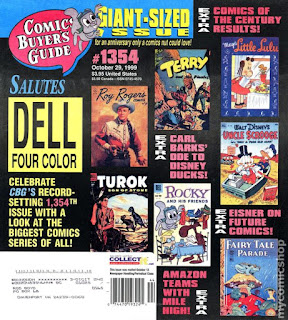 That meant a change in the size of the newshole — an increase, the first in a long time. It also meant that much more of the value of the magazine would be in its editorial content. This was a challenge for the publication, as its editorial budget had always been paltry: many contributors in previous years simply wrote for free, whereas the existence of competitors like Wizard had raised the price of content. The internal staff — which later on at different times included Joyce Greenholdt, Nathan Melby, James Mishler and Ray Sidman — began generating a lot more original content. CBG included much coverage of the gyrations of the distribution market in the 1990s, and Marvel's bankruptcy; censorship made its reappearance with the Planet Comics case. Later, a news-capsule deal was struck with Newsarama, whose Matt Brady had gotten his start writing for Comics Retailer. Michael Doran and Matt contributed many pieces over the years.
That meant a change in the size of the newshole — an increase, the first in a long time. It also meant that much more of the value of the magazine would be in its editorial content. This was a challenge for the publication, as its editorial budget had always been paltry: many contributors in previous years simply wrote for free, whereas the existence of competitors like Wizard had raised the price of content. The internal staff — which later on at different times included Joyce Greenholdt, Nathan Melby, James Mishler and Ray Sidman — began generating a lot more original content. CBG included much coverage of the gyrations of the distribution market in the 1990s, and Marvel's bankruptcy; censorship made its reappearance with the Planet Comics case. Later, a news-capsule deal was struck with Newsarama, whose Matt Brady had gotten his start writing for Comics Retailer. Michael Doran and Matt contributed many pieces over the years.
The 1990s and early 2000s thus saw a lot of experimentation — some of it, admittedly, chasing whatever genre the ad staff saw potential promise in. While there was always a separation between advertising and editorial, there were fishing expeditions into manga, games, and toys. (The only artifact of the game foray is that 1995's CBG #1116 became the highest-selling issue of the magazine ever, including in its polybag an exclusive card for then-white-hot Magic: The Gathering.)
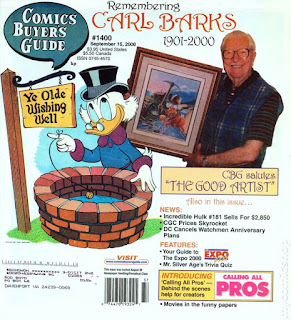 More luck was had following something closer to the core mission: CGC, and the rise of auction houses in the early 2000s. It became
More luck was had following something closer to the core mission: CGC, and the rise of auction houses in the early 2000s. It became
apparent, however, that nostalgia was the major unifying factor in CBG's readership — as typified by popular columnist additions Craig "Mr. Silver Age" Shutt and Andrew "Captain Comics" Smith. It also continued to cover the comics resale market, adding Mile High's Chuck Rozanski as a columnist.
The missing piece, however, was the Internet. CBG had weathered the ups and downs of the hobby by being one of a stable of collector's magazines at Krause. Unfortunately, this safety in numbers tended to make it tougher for a single magazine — one serving early-adopters — to get something the other magazines did not have. Opportunities to acquire or host major comics sites operating today had to be passed on, because of a lack of infrastructure or resources.
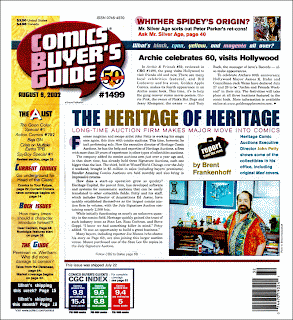 And the competition that proved most damaging to the magazine came not from Internet news sites or other magazines — but rather, eBay. It struck directly at the weekly shopper model, wiping out the classifieds. It was this, among other things, that led to the end of the newspaper format in 2004. Krause had been sold to a private equity firm in 2002 and merged with what is now F+W Media; in 2004, with the firm contemplating another sale (which happened in 2005), CBG abandoned the weekly shopper model to become a monthly magazine, for the first time almost fully dependent on single-copy and subscription sales.
And the competition that proved most damaging to the magazine came not from Internet news sites or other magazines — but rather, eBay. It struck directly at the weekly shopper model, wiping out the classifieds. It was this, among other things, that led to the end of the newspaper format in 2004. Krause had been sold to a private equity firm in 2002 and merged with what is now F+W Media; in 2004, with the firm contemplating another sale (which happened in 2005), CBG abandoned the weekly shopper model to become a monthly magazine, for the first time almost fully dependent on single-copy and subscription sales.
That redesign was assigned to me, and as I wrote in a CBG column a few years ago, it was one of the scariest things I've ever had to do. The history of the magazine was formidable, as were the expectations of the readers. I had asked what percentage we could be allowed to lose and make the changeover work; the answer was one in three.
Fortunately, we didn't go anywhere near that — I think the number of people who canceled was in the single digits. The reason was in part because then-publisher Mark Williams committed to giving the staff, for one year, the same number of pages that would have been in a month of weekly issues. For a year, no issues had fewer than 240 pages — and the second monthly issue, #1596 (September 2004) was the largest ever, at 292 pages. The "big chunk" model had enough room to pursue the three directives the staff had been given: directing one third of the publication toward new comics with lots of reviews, one third toward older readers, with nostalgia pieces, and one third toward collectors, with a price guide section that drew upon actual transactions, digitally culled from — yes, our old nemesis eBay. That was part of a strategy supporting the Standard Catalog of Comic Books line. We threw everything we could find into it. It bought another eight years, and just over a hundred issues.
The new format also allowed CBG to do something it hadn't been able to do before: purchase original art covers. All those covers in the 1990s, almost all, had been promotional pieces. With CBG finally in a format where Barnes & Noble could carry it on the main shelves, what was on the cover mattered. In 2005, CBG also finally got its own website, CBGXtra.com. I developed the initial version of it, one of my last acts before moving on in the company (which I left in 2007). Jim Johnson, John Petty, Brett Weiss, and Michelle Nolan came aboard as contributors.
Brent, who had been promoted to full editor of CBG when Maggie (now Senior Editor) cut her workload at the end of 2007, worked with designer Shawn Williams to put together a nice package each month. The 240-page deal lapsed, and the number of pages was slowly allowed to come back down to balance the books. Color pages became black and white, glossy paper became newsprint, and the price guide was dropped altogether. My own column eventually was, too, although I had taken up residence here at Comichron by then.
The magazine business is in worse shape than the comics
business by far, and while there is still a market for the right magazine model
(Alter Ego, etc.), there evidently wasn't another evolution left in CBG. The staff received news of the cancellation just after the new year. Issue #1699 had already gone to press, so there will be no anniversary issue, nor acknowledgment in the magazine. The last thing in the magazine is, as always, a column by Peter David, who suffered a stroke at the end of 2012.
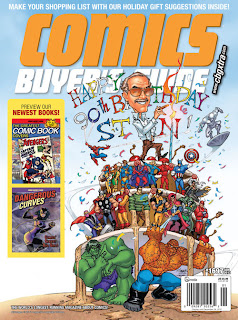 I expected such an announcement sooner, as FW/Krause had already folded Comics & Games
I expected such an announcement sooner, as FW/Krause had already folded Comics & Games
Retailer and the much more lucrative Scrye several years ago; still, I am deeply saddened to see it come to pass, both for the history of comics and for the friends and neighbors who worked there.
Maggie Thompson continues to blog on her website; her Twitter feed is @ThompsonMaggie. I'm working with her on a number of comics research activities. Maggie will also be blogging for Comic Con International's new Toucan blog. Brent's new Twitter feed is @BFrankenhoff, and I know he's going to stay active in the field as well.
There is no digital archives of CBG, beyond the DVDs produced for the last few years. Krause did not own the rights to many of the columns that appeared in the 1980s and 1990s, and excising that material would have been impractical. Lone Star has a huge assortment of back issues available.
As a reader in high school, CBG gave a sense of community; as an editor, it gave me the chance to talk comics with thousands of people at once, and to advance some of my historical interests. The magazine changed my life, and I know that it touched others as well.Update: Maggie's blog post appears here.
Follow Comichron on Facebook and Twitter!




